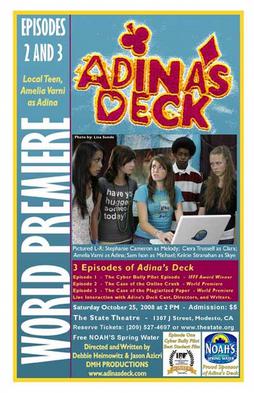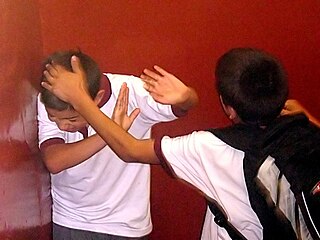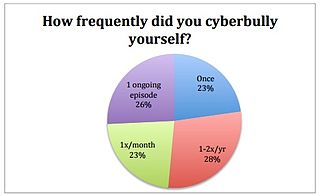Related Research Articles
Gay bashing is an attack, abuse, or assault committed against a person who is perceived by the aggressor to be gay, lesbian, bisexual, transgender or queer (LGBTQ+). It includes both violence against LGBT people and LGBT bullying. The term covers violence against and bullying of people who are LGBT, as well as non-LGBT people whom the attacker perceives to be LGBT.

Bullying is the use of force, coercion, hurtful teasing or threat, to abuse, aggressively dominate or intimidate. The behavior is often repeated and habitual. One essential prerequisite is the perception of an imbalance of physical or social power. This imbalance distinguishes bullying from conflict. Bullying is a subcategory of aggressive behavior characterized by hostile intent, imbalance of power and repetition over a period of time.
School violence includes violence between school students as well as attacks by students on school staff and attacks by school staff on students. It encompasses physical violence, including student-on-student fighting, corporal punishment; psychological violence such as verbal abuse, and sexual violence, including rape and sexual harassment. It includes many forms of bullying and carrying weapons to school. The one or more perpetrators typically have more physical, social, and/or psychological power than the victim. It is a widely accepted serious societal problem in recent decades in many countries, especially where weapons such as guns or knives are involved.
Relational aggression, alternative aggression, or relational bullying is a type of aggression in which harm is caused by damaging someone's relationships or social status.
Teen dating violence is the physical, sexual, or psychological / emotional abuse within a dating relationship among adolescents. Intimate partner violence (IPV) has been a well examined and documented phenomenon in adults; however, there has not been nearly as much study on violence in adolescent dating relationships, and it is therefore not as well understood. The research has mainly focused on Caucasian youth, and, as of 2013, there are no studies which focus specifically on IPV in adolescent same-sex relationships.

Adina's Deck is a 2007 American DVD film series about internet safety and aimed toward 9- to 15-year-old children. The series is intended to be used alongside the series' official website and curriculum to inform and instruct children about cyberbullying and how to prevent it. The series was directed and written by Jason Azicri and Debbie Heimowitz, and was evaluated by Stanford University for its suitability as a teaching aid.

School bullying, like bullying outside the school context, refers to one or more perpetrators who have greater physical strength or more social power than their victim and who repeatedly act aggressively toward their victim. Bullying can be verbal or physical. Bullying, with its ongoing character, is distinct from one-off types of peer conflict. Different types of school bullying include ongoing physical, emotional, and/or verbal aggression. Cyberbullying and sexual bullying are also types of bullying. Bullying even exists in higher education. There are warning signs that suggest that a child is being bullied, a child is acting as a bully, or a child has witnessed bullying at school.
Pink Shirt Day is an annual event against bullying, held in Canada and New Zealand. Participants wear pink shirts and attend or host informative events to raise awareness about bullying, particularly in schools. Pink Shirt Day was started in 2007 in Canada, where it is held on the last Wednesday of February each year. It was adopted in New Zealand in 2009 and is observed annually on the third Friday of May.
Youth suicide is when a young person, generally categorized as someone below the legal age of majority, deliberately ends their own life. Rates of youth suicide and attempted youth suicide in Western societies and other countries are high. Youth suicide attempts are more common among girls, but adolescent males are the ones who usually carry out suicide. Suicide rates in youths have nearly tripled between the 1960s and 1980s. For example, in Australia suicide is second only to motor vehicle accidents as its leading cause of death for people aged 15 to 25.
Research has found that attempted suicide rates and suicidal ideation among lesbian, gay, bisexual, and transgender (LGBT) youth are significantly higher than among the general population.
Sexting is sending, receiving, or forwarding sexually explicit messages, photographs, or videos, primarily between mobile phones. It may also include the use of a computer or any digital device. The term was first popularized early in the 21st century and is a portmanteau of sex and texting, where the latter is meant in the wide sense of sending a text possibly with images. Sexting is not an isolated phenomenon but one of many different types of sexual interaction in digital contexts that is related to sexual arousal.
Researchers study Social media and suicide to find if a correlation exists between the two. Some research has shown that there may be a correlation.
Bullying suicide are considered together when the cause of suicide is attributable to the victim having been bullied, either in person or via social media. Writers Neil Marr and Tim Field wrote about it in their 2001 book Bullycide: Death at Playtime.
Helen Cowie FBPS, PGCE, is Emeritus Professor in the Health and Social Care division of the Faculty of Health and Medical Sciences at the University of Surrey.
Anti-bullying legislation is a legislation enacted to help reduce and eliminate bullying. This legislation may be national or sub-national and is commonly aimed at ending bullying in schools or workplaces.

David Allen Wolfe is an academic, psychologist and author specializing in issues of child abuse, domestic violence, children and youth. His work includes the promotion of healthy relationships through school programs, with a major focus on the prevention of child abuse and neglect, bullying, dating violence, unsafe sex, substance abuse and other consequences of unhealthy relationships.
Cyberbullying is a form of bullying or harassment using electronic means. It has become increasingly common, especially among teenagers and adolescents, due to young people's increased use of social media. Related issues include online harassment and trolling. In 2015, according to cyberbullying statistics from the i-Safe Foundation, over half of adolescents and teens had been bullied online, and about the same number had engaged in cyberbullying. Both the bully and the victim are negatively affected, and the intensity, duration, and frequency of bullying are three aspects that increase the negative effects on both of them.

Empathy has been studied in the context of online communities as it pertains to enablers of interpersonal communication, anonymity, as well as barriers to online relationships, such as ambiguity, cyberbullying and internet trolling. The importance of this topic can not be underestimated as the landscape of online use drastically changed or evolved following the Covid-19 Pandemic of 2020 which forced many in the workplace, schools and even novice tech users into new and uncomfortable situations. This forced much more time spent and reliance on the virtual world, through our computers, phones, and tablets. Schools and workplaces moved online consumers also moved online for basic needs like grocery shopping, medical appointments and a host of new virtual services that impacted all generations.
Online child abuse is a unique form of child abuse also known as “Cyber Molestation” due to its virtual, distanced, and anonymous nature. Such abuse may not happen face-to-face, nor does it necessarily require physical contact. However, online abuse can result in negative face-to-face consequences in the form of statutory rape, forcible sexual assault, harassment, etc. In the United States, online child abuse is recognized as a form of child abuse by the National Society for the Prevention of Cruelty to Children.

Auto-trolling, self-cyberbullying, digital Munchausen or digital self-harm is a form of self-abuse on the Internet. It is usually done by teenagers posting fake insults on social media, attacking themselves to elicit attention and sympathy. A study in 2012 found that about 35 per cent of those who did this felt better. Studies in 2016 and 2019 found an increase in prevalence in American adolescents rising from 6 to 9 per cent. In a 2011 study, boys were more likely than girls to admit to digital self-bullying. In a 2022 study published by researchers Justin Patchin, Sameer Hinduja, and Ryan Meldrum, US youth who engaged in digital self-harm were between five and seven times more likely to have considered suicide and between nine and fifteen times more likely to have attempted suicide.
References
- ↑ "Sameer Hinduja | Berkman Klein Center". 28 April 2022.
- ↑ "International Journal of Bullying Prevention / Home". Springer Publishing . Retrieved 2022-12-14.
This peer reviewed journal provides an interdisciplinary scientific forum in which to publish current research on the causes, forms, and multiple contexts of bullying and cyberbullying as well as evolving best practices in identification, prevention, and intervention.
- ↑ "Books". Cyberbullying Research Center. December 24, 2017. Retrieved February 20, 2024.
- ↑ "Google Scholar". Google Scholar. Retrieved January 7, 2023.
- ↑ "Journal Articles". Cyberbullying Research Center. December 24, 2017. Retrieved February 20, 2024.
- ↑ Staff (2022-08-23). "Sameer Hinduja | Berkman Klein Center". cyber.harvard.edu. Retrieved 2022-11-21.
- ↑ Hinduja, Sameer (June 16, 2022). "Federal Testimony on Cyberbullying and Social Media". Vimeo. Retrieved January 7, 2023.
- ↑ "Sameer Hinduja - Preventing Cyber-Bullying through School Climate and Youth Kindness Initiatives". YouTube. February 12, 2015. Retrieved January 7, 2023.
- ↑ "Tween Statistics (9- to 12-year-olds)". Cyberbullying Research Center. December 18, 2020. Retrieved January 7, 2023.
- 1 2 Hinduja, Sameer; Patchin, Justin W. (2015). Bullying beyond the schoolyard : preventing and responding to cyberbullying. Thousand Oaks, California: Corwin. ISBN 978-1-4833-4993-0. OCLC 889666432.
- ↑ "Get the Facts on Bullying and Cyberbullying". ADL News. Anti-Defamation League. 2014-01-30. Retrieved 2023-01-07.
- ↑ "Dr. Sameer Hinduja – Board Member - International Bullying Prevention Association". IBPA - International Bullying Prevention Association. July 7, 2017. Retrieved January 7, 2023.
- ↑ "Stop Bullying Speak Up - Research and Resources". Cartoon Network. May 1, 2018. Retrieved January 7, 2023.
- ↑ "Introducing the Twitch Safety Advisory Council". Twitch Blog. May 14, 2020. Retrieved January 7, 2023.
- 1 2 "Q&A with Sameer Hinduja and Justin Patchin of the Cyberbullying Research Center - Meta Research". Meta Research. April 15, 2021. Retrieved January 7, 2023.
- ↑ Hinduja, Sameer (December 24, 2017). "How to Identify, Prevent, and Respond". Cyberbullying Research Center. Retrieved January 7, 2023.
- ↑ Hinduja, Sameer; Patchin, Justin W. (2024). Bullying beyond the schoolyard : preventing and responding to cyberbullying. Thousand Oaks, California. ISBN 978-1-0719-1656-8.
{{cite book}}: CS1 maint: location missing publisher (link) - ↑ Patchin, Justin W.; Hinduja, Sameer (2016). Bullying Today: Bullet Points and Best Practices. Thousand Oaks, California: Corwin. doi:10.4135/9781506335957. ISBN 978-1-5063-3597-1.
- ↑ Patchin, Justin W.; Hinduja, Sameer (2014). Words wound : delete cyberbullying and make kindness go viral. Minneapolis, MN: Free Spirit Publishing. ISBN 978-1-57542-451-4. OCLC 836206093.
- ↑ Hinduja, Sameer; Patchin, Justin W. (2012). School climate 2.0 : preventing cyberbullying and sexting one classroom at a time. Thousand Oaks: Corwin Press. ISBN 978-1-4129-9783-6. OCLC 764334392.
- ↑ Patchin, Justin W.; Hinduja, Sameer (2012). Cyberbullying prevention and response : expert perspectives. New York: Routledge. ISBN 978-1-136-73529-5. OCLC 743805894.
- ↑ "Single-Minded Focus - TEDx 2013 - Sameer Hinduja". YouTube . 15 June 2014.
- ↑ "The Lost Art of Listening - TEDx 2014 - Sameer Hinduja". YouTube . 15 June 2014.
- ↑ "Comparing Ourselves to Others | Sameer Hinduja | TEDxFAUJupiter". YouTube . 27 April 2015.